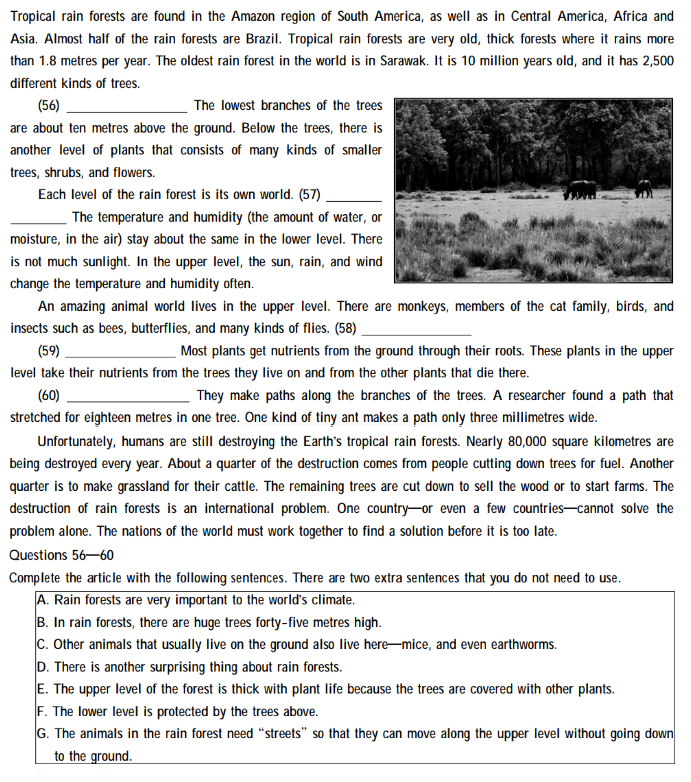2022年全国大英赛阅读理解题型解读及例题分析
时间:2022-11-08 16:51 浏览:次
阅读理解部分是全国大学生英语竞赛的分数大项,共 30分。阅读文章的题材通常是社会生活、经济、教育、文化、科普等方面的内容,体裁为议论文、说明文、叙述文、描述文。该部分文字量大,答题时间紧,难度较高。阅读理解的文章涉及的词汇丰富,语法全面,内容广泛,是考查考生阅读速度、词汇量、语法知识及其分析、判断、推测、归纳和总结能力的重要手段。
阅读能力包括较快的阅读速度和较强的理解能力。所谓“较强的理解能力”是指应具有:1. 掌握所读材料主旨和大意的能力。2. 了解说明主旨和大意的事实和细节的能力。3. 既能理解字面的意思,又能根据所读材料进行一定的判断和推理的能力。4. 既理解个别句子的意思,又能理解上下文的逻辑关系的能力。阅读速度是阅读最基本的能力,没有一定的阅读速度,就不能顺利地获取信息,更谈不上提高阅读理解能力。许多考生在做阅读理解题时都有超时的现象,这说明考生的阅读速度与考试要求还有一定的差距。而且,许多考生没有养成良好的阅读习惯,在平时的阅读中仍沿袭初学英语时的阅读方法,即我们常见的出声朗读或不出声朗读。这两种阅读方法极不适合大学生英语竞赛中大题量且要求阅读速度快的阅读理解部分。
除了上面提到的阅读速度和方法问题之外,还有其他一些消极因素影响考生的应试效率:语言障碍。主要表现在词汇量小、语法概念不清楚、语意理解能力差等几个方面,其中尤其是以词汇量小为主。由于考生平时词汇积累不够,在阅读过程中往往被生词所阻,无法更好地理解文章,从而在阅读时把注意力放在局部而不是整体上。许多考生阅读时把精力放在字词句上,而忽略了对整篇文章的理解和记忆,阅读方法与答题步骤欠妥。许多考生在做阅读理解题时,拿来就读,而且逐字逐句地研读,不讲究一定的方法、步骤;知识面狭窄,文理科知识互渗不够。参加竞赛的考生,由于所学专业的限制,文理知识不能相融。考生在兴趣和爱好上的不同也会导致他们的阅读方向的不同,因此,阅读材料中一旦涉及他们不熟悉的内容,就会不知所措,严重影响阅读效果。
在此,我们结合全国大学生英语竞赛的部分试题,分析阅读理解题的题型和答题策略。
【题型解读】
阅读理解部分较去年去掉了一个篇章,同时去掉了段落匹配题型,请同学们注意。2022年阅读理解题共包含3篇文章,最新题型设有:
1.选择题,即从七个选项中选择五个以使文章内容完整;
2.简答题,即根据文章内容回答问题;
3.完成摘要题,即从文章中选出词或短语填空,答案基本上都是文章中出现过的词,根据语境可改变词的形式。
(一)选择题
试题模式为:给出一篇缺少5 个句子的文章,对应有7 个选项,要求根据文章结构、内容,选出正确的句子,填入相应的空白处。试题的难度较常规阅读试题有所增加,而且会出现“一处误选”导致“多处误选”的后果。根据试题的特点,在实际做题过程中,同学们不妨采用“先看选项定位含义—再看正文仔细分析—最后把选项与正文对应确定答案”的模式。
【题例解析】
Section A (10 marks)
Questions 56—60 are based on the following passage.

【参考答案】
56-60 BFCEG
(二)简答题
不同类型的问题要求有不同形式的回答,不能仅仅为了答案的简洁而忽略了问题与答案在形式上的对应。比如,就目的进行提问时,答案就应当用表示目的的用语,如 for短语,不定式短语;就原因进行提问时,就应当用 because of短语或because从句回答;提问词是 what时,只能用名词或名词性短语、名词性从句来回答。尽可能利用原文中的关键词语回答问题。总之,简答题基于理解,重在表达,简答题的答案要精炼概括,言简意赅,力争体现“简”与“准”。
【题例解析】
Section B
Questions 61—65 are based on the following passages.
One of the interesting things about languages is the way they change over time. In English, everything from spelling to vocabulary has gone through major changes over the years. In fact, to a modern speaker, the English of 1,000 years ago looks like a foreign language!
The history of English dates back around 1,500 years. At that time, groups of Europeans invaded England, bringing their language with them. It developed into Old English. Later, in 1066, England was invaded by the Normans from France. The language went through an important shift, leading to what we now call Middle English. Over the next 500 years, the language under went further shifts, leading to Modern English. As the language has developed over time, many things about it have changed.
Pronunciation is one of the most obvious areas. For example, in Old English, people said “hus” and “mus”. Now, we say “house” and “mouse”. These days, there are many differences in the way English is pronounced in the U.S., India, and elsewhere. When people live in groups separated by great distances, the pace of change can be fast.
Spelling has also gone through interesting changes. For example, in Old English, one wrote “riht”. A “g” was added in Middle English, making the spelling “right”. Also, in the distant past, people did not always follow standards of spelling. In the eighteenth and nineteenth centuries, scholars like Noah Webster wrote dictionaries which made the spelling more consistent. However, different standards were decided on in England and the U.S. So, some differences remain—for example, “color” vs. “colour”.
Vocabulary changes happen even more quickly. English has grown by borrowing words from languages such as French, Spanish, and Arabic, to name a few. This often happens with types of food—for example, “tofu”. Then there is slang which enters and leaves the language every year! Thirty years ago, one often heard people saying “groovy”, meaning “great”. These days, you’ll rarely hear the word except on old TV shows and movies.
Because English is spoken by so many people worldwide, it really is an exciting time for the language. Just as American and British versions are always changing, so are versions spoken in Canada, Singapore, and elsewhere. At the same time, an entirely new version of English is appearing on the Internet with whole new slang and writing styles. In a way, learning English is an ever-ending process, even for native speakers!
Questions 61—65
Answer the following questions according to the passage.
61. Why does the English of 1,000 years ago seem a foreign language to modern speakers?
62. What aspects are discussed to show the changes of English in history?
63. When did scholars try to make English spelling more consistent?
64. What are some languages that English has borrowed words from?
65. Where can we see an entirely new version of English?
【参考答案】
61. Because in English, everything from spelling to vocabulary has gone through major changes over the years.
62. Pronunciation, spelling and vocabulary.
63. In the eighteenth and nineteenth centuries.
64. Languages such as French, Spanish, and Arabic.
65. On the Internet.
(三)完成摘要
首先要阅读原文,抓住表达文章主旨大意的关键词或中心句。对于一些关键的句子,可以边读边在下面画线标出,便于做题时查找。另外,对原文的各个段落的大意也要做到心中有数。做题时,涉及某一部分的内容时,就可以迅速地到原文的相关段落中查找。
【题例解析】
Section C
Questions 66—70 are based on the following passages.
The average automatic teller machine (ATM) is not very smart. It will give money to anyone who has the right card and punches four or five keys in the right order. Some analysts estimate that as many as 30% of ATM transactions worldwide are cases of theft. To increase security at cash machines, some banks have tried to make their ATMs a little smarter. A small camera on the machine looks directly into the eye of every customer. Its cans one iris and compares the tiny patterns of ridges, dots, and other features to a code in its computer. If there is a match, the ATM will start counting out cash. If not, a message is automatically sent to the nearest police station.
Iris-scanning is one fast-growing form of biometric identification—determining who someone is by examining features of the body. One of the earliest biometric techniques was fingerprinting. The lines on fingertips are unique to each person, so not even identical twins have the same fingerprints. Fingerprinting has become famous as a way of finding out who committed a crime, but it very often fails. A careful criminal can wear gloves, avoid touching things, or even alter his fingerprints by burning, cutting, or scraping them. In the search for a more reliable system, security experts have focused on the eye.
Like a fingerprint, every iris is, for all practical purposes, unique. Each person’s right iris is even different from his or her left one. A low-cost digital camera, like the kind installed at ATM machines, can easily detect hundreds of different features in the iris. The chance of two irises having the same features is close to zero. Tests have shown that iris-scanners are very hard to fool. They can tell the difference between a real iris and a false one. They can see right through coloured contact lenses, eyeglasses, and even mirrored sunglasses. Although many criminals are willing to burn or cut their fingers in pursuit of the perfect crime, few would be willing or able to alter their irises.
To make iris-scanning work, a computerized database has to match certain iris features with certain people. This means that each ATM customer has to allow a bank to photograph his or her iris and keep that highly personal information in a computer. Some people have worried, however, that an increased use of iris-scanning will lead to a dangerous loss of privacy. By mounting iris-scan cameras in public places, governments could track a private citizen all day long without the person’s knowledge. This would be a great advantage to the police, but it could also give corrupt officials a new way to control their opponents. The military’s development of tiny robots suggests that government iris-scanners could even invade private homes!
Questions 66—70
Complete the summary with words from the passage, changing the form where necessary, with only one word for each blank.
ATM transactions are often cases of theft, where an unauthorized user takes (66). To decrease in security, some banks have installed iris-scanning machine sat ATMs. These small cameras scan the user’ s iris, recording its features and (67) them to a digital file. Every person has a (68) iris, making iris identification highly reliable. Earlier efforts at biometric identification often relied on fingerprints. However, fingerprints can easily be (69) through cutting, burning or scraping. Iris scanners are so effective that they can even see through contact lenses and mirrored sunglasses. Use of iris scanners would provide great advantages to the police. However, others worry about a loss of (70).
【参考答案】
66. money
67. comparing
68. unique
69. altered
70. privacy
微信扫描下方二维码,关注“英语考试与竞赛”公众号回复 “大英赛”即可获取往届竞赛真题! (责任编辑:jingsai) |
